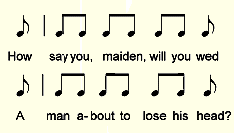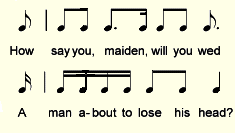 |
 |
||||||
The first thing I have to decide upon is the rhythm, and I arrange the rhythm before I come to the question of melody.
| Arthur Sullivan, explaining his method of composition to his biographer, Arthur Lawrence, in 1899. |
| A wandering minstrel I — | |
| A thing of shreds and patches, Of ballads, songs and snatches, |
|
| And dreamy lullaby! | |
I think he would have used the rhythm of Ex. 1. For this is the present rhythm and metre of the verse. Arthur Sullivan, however, casts the words to the rhythm of Ex. 2. [Note 1] That is, he follows the suggestion of the verse-rhythm for the first, third and fourth lines but fractures the one-to-one regularity of music on words by beginning the second line (at "A thing") too soon and then stretching it (at "shreds") in the middle. The result is a pleasing new shape for the four-line unit (a shape itself then established as a regularity for the song).
| Ex. 1 |  |
| Ex. 2 |  |
Gilbert's operetta verse is almost always strictly regular, both in line-length and internal line-rhythm as well as in rhyme scheme. Sullivan, indeed, often sets these verses with the "singsong" rhythm directly copied from the verse (complete with expected pauses at the ends of lines: poetic trimeter, for example, becomes four-beat-measured music, each fourth beat empty until the pick-up that may begin the next line of poetry); but, with significant frequency, he works as he does in the foregoing Mikado example, counterpointing the rhythm of the verse against a new regularity in the music. The result is refreshing but also subtle, for the patterning of verse lurks under the more directly experienced unfolding of the music.
Some results of this kind of "counterpoint" can be seen in an example of straight poetry. If Robert Browning's My Last Duchess is "performed" — that is, read naturally, even if only in the mind's ear — it comes out like this:
| That’s my last Duchess painted on the wall, | |
| Looking as if she were alive. | |
I call That piece a wonder, now: |
|
(where each “line” is read steadily to the end, with a pause before moving on). In this reading, the rhymes seem to occur at uneven or random times:
| That’s my last Duchess painted on the wall, | |
| Looking as if she were alive. | |
I call That piece a wonder, now: |
|
But in fact those rhyming words are evenly spaced: for lurking just under the “sung” surface of the performed version of the poem is the poet’s regularity of line-length (and thus rhyme appearance, since the rhyming words conclude these lines), as of course indicated clearly by the original form of the lines printed on the page. If in the following, the italicised syllables are artificially stressed and the end-rhymes forcibly accented, the underlying rhythm (lacking only regularity of beat contents but yet with the rhyme occurring every four “beats”) is revealed. A forced pause at the ends of lines 2 and 3 will further clarify the matter:
That’s my last Duchess painted on the WALL,
Looking as if she were alive. I CALL
That piece a wonder, now: Frà Pandolf’s HANDS
Worked busily a day, and there she STANDS.
The result of the hiding of one rhythm beneath the other is, I feel, a counterpoint in the verse itself. In naturally read form, the rhyming words appear like Christmas tree lights or blinking stars randomly dotting the field. It is even surprising to discover — albeit with great force, denying the run-on feature constant throughout — that such a regularity actually times the appearance of the rhymed words.
I believe Sullivan achieved a similar result with Gilbert’s verses and that this characteristic of their joint work keeps it fresh and light. Several one-to-one songs will go by, the rhythm of Sullivan’s music duplicating that of Gilbert’s poetry, and then an exception will occur in which the song has of course the regular pattern of its own (for such is the general style within which this genre exists: as opposed to the surface of the Browning poem, which aims at no rhythmic patterning but only at normal English prosody), but this pattern is different from that of the verse that is simultaneously — in fact thereby — presented.
Later in The Mikado the following verse occurs:
| Comes a train of little ladies | |
| From scholastic trammels free, | |
| Each a little bit afraid is, | |
| Wondering what the world can be! | |
The regularity of the verse (each line has the same scanning, except that lines 1 and 3 have an extra unaccented last syllable) is treated by the composer in a way related to the above and particularly typical of him. The first three lines are set “straight” (again, to within melismatic elaboration within poetic feet: the first six quavers below are actually six pairs of slurred semiquavers), but the fourth is altered (see Ex. 3). Here, the fourth line (“Wondering…”) is begun “early” (hence my inclusion of that word at the end of music line 3); this yields a run-on effect, which is then compensated for by the stretching of the final syllables (“world” and “can” should be quavers if the verse-rhythm were copied exactly for all four lines). Again the result is a breaking of the singsong pattern, the final rhyme seeming not to occur at the right time (although it does in fact sound in place, the contraction and stretch having just balanced each other out). [Note 2]
| Ex. 3 |  |
Often, indeed, Sullivan does make the rhyme come too soon or too late:
How say you, maiden, will you wed
A man about to loose his head?
In straightforward poetic reading of this couplet from The Yeomen of the Guard, “head” and “wed” appear after equal amounts of verbal time (see Ex. 4). But in Sullivan’s setting the second line is compressed (see Ex. 5) [Note 3] so that the word “head” occurs a beat earlier than expected (according to “verbal time”). This pattern then becomes the musical norm for the song, a constant counterpoint to the underlying verse structure (but again, as so often with Sullivan, itself varied as the song unfolds).
| Ex. 4 |  |
| Ex. 5 |  |
Sometimes the rhyme occurs regularly in the music but the space between rhyme points is subjected to a contortion not found in the verse rhythm (and then maintained for the song). In H.M.S. Pinafore the following verse occurs:
| A many years ago, | |
| When I was young and charming, | |
| As some of you may know, | |
| I practised baby-farming. | |
The timing and placement of musical stresses fully agrees with the verse, as represented below, where the xs are placed to show the succession of regularly spaced music beats (a hand clap at each such point while reciting the verse evenly will produce the flow of the music):
| x | x | x | x | ||||
| A | man- | y | years | a- | go. | ||
| x | x | x | x | ||||
| When | I | was | young | and | charm- | ing, | |
| x | x | x | x | ||||
| As | some | of | you | may | know, | ||
| x | x | x | x | ||||
| I | prac- | tised | ba- | by | farm- | ing. |
But six operettas later, in Ruddigore, the same verse-plan occurs:
| Sir Rupert Murgatroyd | |
| His leisure and his riches | |
| He ruthlessly employed | |
| In persecuting witches. | |
This time, however, the composer places the musical stress (again regularly spaced in time and regularly filled) as follows (where the lines of words are shown according to music-measured groupings, which this time do not correspond to the printed lines of verse):
| x | x | x | x | |||||
| Sir | Ru- | pert | Mur- | ga- | troyd | His | lei- | sure |
| x | x | x | x | |||||
| and___________ | his | rich- | es | |||||
| x | x | x | x | |||||
| He | ruth- | less- | ly | em- | ployed | In | per- | se |
| x | x | x | x | |||||
| cu-__________ | ting | witch- | es. | |||||
If claps are made at each x, regularly spaced in time, the effect will be achieved. In both the Pinafore and Ruddigore examples, the rhyming words occur on the third of each four-grouped musical beats. But in the latter case, lines 2 and 4 begin “soon” and are in consequence stretched (the xs without new syllables). The sense of compression and expansion, again established as the norm for the song, once again synchronises with but counterpoints against the regular text — which, for me, is thereby enlivened and enriched.
There are indeed examples of more thoroughgoing invention of musical rhythm against verse-rhythm in these works: I think immediately of “Were I thy bride” from The Yeomen of the Guard or “So please you, Sir, we much regret” from The Mikado. Anyone familiar with these songs will have to read the text resolutely “straight”, from the printed libretto alone, in order to be quite surprised by the extremely different but of course completely typical simplicity in the pattern of the underlying verse. For perhaps one out of every half-dozen songs of Gilbert set by Sullivan, the combined surface resembles that of My Last Duchess: a blend of two harnessed patterns presented in a single unfolding. For me, this particular feature contributes to the raising of Sullivan’s Gilbert-inspired music above that of other composers of similar style and bent.
Page modified 12 October, 2006